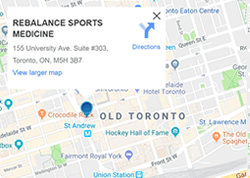Facet Joint Dysfunction: Causes, Symptoms, Treatment and Exercises
 Facet joints are the articulations formed between two adjacent vertebrae (bones) in the spine. There are two facet joints between each vertebra, and they are responsible for segmental movement in the spine. The facet joint surfaces are lined with cartilage and are surrounded by a fibrous capsule, ligaments, muscles and exiting nerve roots.
Facet joints are the articulations formed between two adjacent vertebrae (bones) in the spine. There are two facet joints between each vertebra, and they are responsible for segmental movement in the spine. The facet joint surfaces are lined with cartilage and are surrounded by a fibrous capsule, ligaments, muscles and exiting nerve roots.
What is Facet Joint Dysfunction?
Facet joint dysfunction arises when there is abnormal wear and tear of the joints, affecting the cartilage and fibrous capsule. This wear and tear can result in spinal pain and limited movement. The surrounding muscles may become tight and feel like they are in spasm.
What Causes Facet Joint Dysfunction?
Abnormal force absorption of the spinal structures results in this wear and tear. Facet joint dysfunction can occur because of degeneration, trauma, or repetitive strain.
Degeneration of the spine decreases vertebral disc (soft ligament-like structure between vertebrae) height and causes increase loading onto the facet joints. This will accelerate the degeneration of the cartilage on the facet joint surfaces, leading to osteoarthritis and pain.
Facet joint dysfunction can also occur from traumatic events such as quick twists or extension type movements (whiplash in car accidents). This causes forceful impaction of the facet joints, damaging the articular cartilage or fibrous capsule, which creates an acute inflammatory response.
Prolonged facet joint compression, occurring from poor sitting posture, or repetitive movements that constantly compress the facet joints, will over time wear down the cartilage of the facet joints and result in pain and dysfunction.
How can Physiotherapy, Chiropractic and Massage Therapy help with Facet Joint Dysfunction?
A Physiotherapist and or Chiropractor can diagnose a facet joint dysfunction and help to alleviate the pressure from the joint surfaces with manual therapy techniques. They will prescribe mobility exercises to regain spinal flexibility and strengthening exercises (specifically core) to limit the excessive strain placed on the joints.
A Registered Massage therapist can help decrease the tone and spasm of the surrounding muscles to decompress the joint. They may also recommend or communicate with your treating Physiotherapist or Chiropractor what areas to focus on strengthening.
What Should be Avoided with Facet Joint Dysfunction?
With facet joint dysfunction, end range extension and rotation of the spine should be avoided as these movements will increase compression of these joints.
How Long Does it Take to Recover from Facet Joint Pain/Dysfunction?
With proper treatment, an acute facet joint dysfunction can resolve within a few weeks. However, there can be underlying degeneration of the spine that can prolong the recovery. A good treatment plan will be more condensed at the start-up to two visits per week until the pain has been managed and continue weekly or every few weeks until your strength and spinal mobility has improved. Typically, you will need to be seen for 3-6 months and possibility some monthly-yearly check ins in more advanced cases.
What are Safe Home Exercises I can do for Facet Joint Dysfunction?
Safe home exercises that can be done for Facet Joint Dysfunction include:
Cat/camel
 Starting on all fours, round out back and tilt head down, stopping before pain. Then look up and arch backwards, stopping before pain.
Starting on all fours, round out back and tilt head down, stopping before pain. Then look up and arch backwards, stopping before pain.
Thread the needle
 Start on all fours, turn body and raise arm to ceiling, stopping before pain. Then rotate to the opposite direction and thread your arm along the floor under the opposite arm, stopping before pain.
Start on all fours, turn body and raise arm to ceiling, stopping before pain. Then rotate to the opposite direction and thread your arm along the floor under the opposite arm, stopping before pain.
Bridge
 Start on your back with knees bent. Actively contract core muscles by drawing in your belly button, contract glutes, and raise hips to ceiling, stopping before pain.
Start on your back with knees bent. Actively contract core muscles by drawing in your belly button, contract glutes, and raise hips to ceiling, stopping before pain.
Bird dog
 Start on all fours, keep lower back in neutral and head and neck retracted. Raise arm and opposite leg, stop before pain. Repeat with the opposite arm and leg.
Start on all fours, keep lower back in neutral and head and neck retracted. Raise arm and opposite leg, stop before pain. Repeat with the opposite arm and leg.
Facet joint dysfunction can be painful and impact your quality of life. Our professionals are Rebalance commonly treat this condition and have great success in getting patients back to their goals and lifestyle. If you think you are experiencing Facet Joint pain, then contact us to book an initial assessment with one of our highly trained Physiotherapists, Chiropractors or Registered Massage Therapists.
Rebalance Toronto
Rebalance Sports Medicine is a multidisciplinary clinic in downtown Toronto offering physiotherapy, chiropractic, registered massage therapy, sports medicine, naturopathy, Pilates and more.



 What to Expect From Your First Physiotherapy Visit
What to Expect From Your First Physiotherapy Visit The Benefits of Fascial Stretch Therapy [Demo]
The Benefits of Fascial Stretch Therapy [Demo] How Does Physiotherapy Work?
How Does Physiotherapy Work? Best Exercises for Low Back Pain
Best Exercises for Low Back Pain